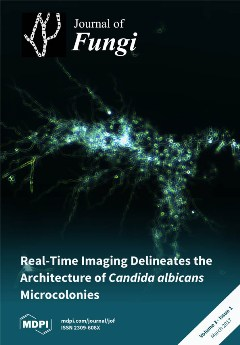We evaluated the activity of (1) amphotericin-B (AMB), combined with rifampicin (RIF), clarithromycin (CLA),
N-acetylcysteine (NAC), ethylenediaminetetraacetic acid (EDTA), and farnesol (FAR) (1000, 1000, 1000, 4000, and 30,000 mg/L, and 300 µM, respectively), against
Candida tropicalis biofilms formed on polytetrafluoroethylene (PTFE) and
[...] Read more.
We evaluated the activity of (1) amphotericin-B (AMB), combined with rifampicin (RIF), clarithromycin (CLA),
N-acetylcysteine (NAC), ethylenediaminetetraacetic acid (EDTA), and farnesol (FAR) (1000, 1000, 1000, 4000, and 30,000 mg/L, and 300 µM, respectively), against
Candida tropicalis biofilms formed on polytetrafluoroethylene (PTFE) and (2) anidulafungin (ANF) combined with the same compounds at 8, 10, 5, 40, and 30 mg/L, and 30 µM, respectively, against biofilms formed on titanium. Biofilm growth kinetics were performed in a CDC Biofilm Reactor (CBR). PTFE or titanium disks were removed from the CBR at 24, 48, 72, and 96 h to determine the Log
10CFU/cm
2. Killing kinetics were performed by adding the drugs to 24-h-mature biofilms (time 0). Disks were removed after 24, 48, and 72 h of drug exposure to determine Log
10CFU/cm
2. Viable cells in biofilms were 4.73 and 4.29 Log
10CFU/cm
2 on PTFE and titanium, respectively. Maximum Log
10 decreases in CFU/cm
2 depend on the combination and were: 3.53 (AMB + EDTA), 2.65 (AMB + RIF), 3.07 (AMB + NAC), 2.52 (AMB + CLA), 1.49 (AMB + FAR), 2.26 (ANF + EDTA), 2.45 (ANF + RIF), 2.47 (ANF + NAC), 1.52 (ANF + CLA), and 0.44 (ANF + FAR). In conclusion, EDTA, NAC, RIF, and CLA improve the activity of AMB and ANF against biofilms developed on both surfaces, which could be an effective strategy against
C. tropicalis biofilm-related infections.
Full article






